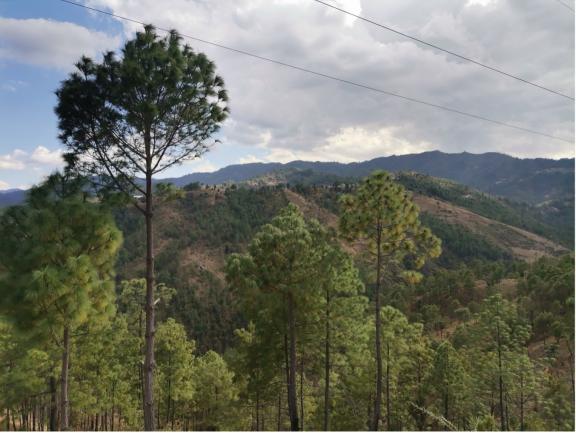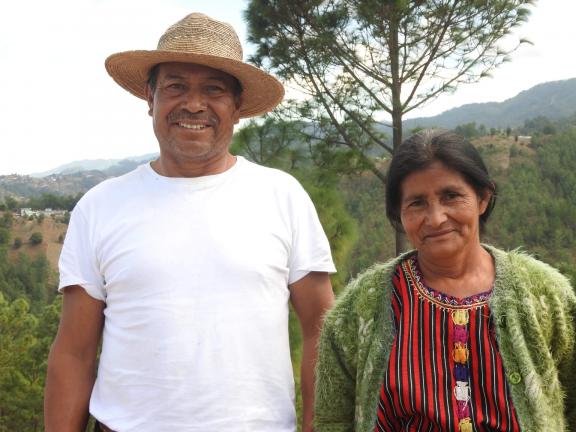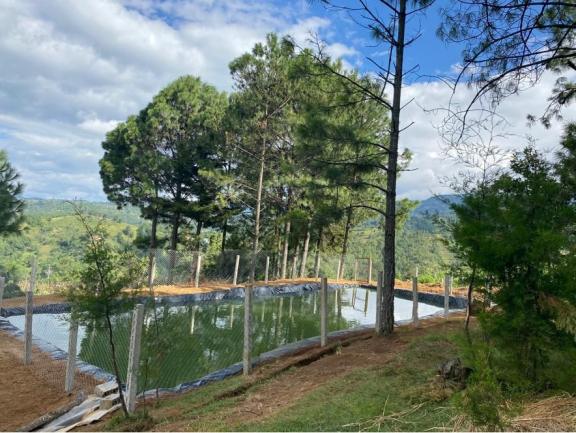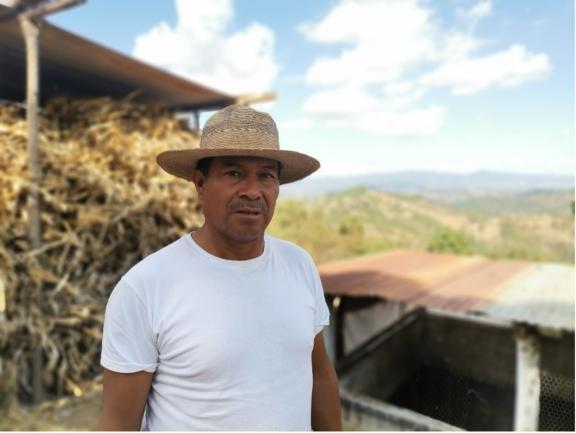Nestled among mountain ranges and a chain of volcanoes, the Guatemalan Highland, the heart of the rich Mayan culture, is one of the most densely populated regions in Central America. 83.5% of its mostly indigenous population struggles from poverty and 33% suffer from extreme poverty. This indigenous community has lived here continuously for thousands of years. The adverse effects of climate change in the region are largely affecting their agricultural yields, and in return, their lives and livelihoods which depend on them.

In the Guatemalan Highlands, small producers depend on maize, beans, or coffee for their livelihoods. They often cultivate on hillsides, or land prone to flooding, water scarcity, enduring adverse climate conditions. Photo: Evelyn Vargas/IUCN
While sitting under the shade of a smooth-bark pine in the village of Xecajá, don Pedro Osorio Pú, 57 years old, reminisces about his life fifty years ago, when he was a child with his future mapped out to be a farmer, following in the footsteps of his father who passed away.

Forests with pine, cypress, oak, and madrone species are characteristic of the life zone. This forest was included in the Keyline system as a water collection zone. Photo: IUCN
Ever since, under the guidance and knowledge of his mother, he has dedicated himself to farming with maize and beans. As he gazes into the horizon, he recalls a completely different landscape with lush forest and abundant water. Today, he says many of his fellow K’iche’ Mayan people have opted to sell their land and migrate, given the harsh conditions for harvesting the land.
Deforestation and forest degradation have caused significant harm to this region causing increased floods and landslides, reduced water infiltration, and water and soil contamination and loss, further exacerbating their vulnerabilities.
The Resilient Highlands project funded by the Green Climate Fund and implemented by the International Union for Conservation of Nature (IUCN), is helping communities in the Guatemalan Highlands to successfully transform their land into a demonstration plot of the Keyline method, a strategy to mitigate micro-watershed degradation.

External view of the Osorio Soc’s—a Mayan K'iche' family—demonstration plot. Photo: IUCN
A Mayan K'iche' family, Don Pedro, doña Santa Soc Osorio, and their five daughters, five sons, two granddaughters, and daughter-in-law, have embraced innovation by adopting this Ecosystem-based Adaptation measure (EbA) on their 1.67-hectare plot of land, located in the Joj micro-watershed in Santa María Chiquimula, Totonicapán, Guatemala.

Don Pedro Osorio and Doña Santa Soc Osorio have implemented Ecosystem-based Adaptation measures (EbA) on their land in the Joj micro-watershed, Santa María Chiquimula, Totonicapán, Guatemala, leading to positive results. Photo: IUCN

Don Pedro and Doña Santa live with their four daughters, daughter-in-law, and two granddaughters. From left to right: Yessica Osorio Soc, Leá Osorio (granddaughter), Pedro Osorio Pú, Dina Osorio Soc, and Floridalma Osorio Soc. Photo: IUCN
The Keyline system—a technique that locates where water flows and directs along land to a reservoir to retain and secure it for the dry season—was promoted by IUCN in partnership with the Ministry of Agriculture, Livestock and Food (MAGA), and support from the Mexican Institute of Water Technology (IMTA) in demonstration plots in the micro-watersheds of the Guatemalan highlands, including that of the Osorio Soc family.
Since 2020, the Resilient Highlands project has been implementing activities to reduce the impact of climate change on the water cycle of watersheds and increase the resilience of local ecosystems and communities.
Don Pedro, who is known for his willingness to try new agricultural methods, shared that he had no prior knowledge of collecting water before the project. However, after learning about the method of having a reservoir for crop cycles, he decided to try it on his land. Recognising his land as an essential agricultural ecosystem and resource, he agreed to have his land evaluated to enable the incorporation of organic fertilisers, and water and soil management techniques such as bench terraces, infiltration trenches, agroforestry systems, and rainwater harvesting methods.

The keyline system in action. Photo: IUCN
Now, in this 1.67-hectare plot, his family have trees of seven forest species such as pine, cypress, oak, and madrone; nine fruit species, five vegetables including curcubits, together with traditional staples like maize and beans. They also raise cows, sheep, chickens, geese, pigs, and turkeys.

Demonstration plots for climate change adaptation combine water and soil management techniques, including rainwater harvesting, erosion control, and organic matter production, based on the area’s microclimatic conditions. Photo: Evelyn Vargas / IUCN
Pedro and Doña Santa’s family all play an active role in food preparation, seed selection, and selling the harvest on their land. Floridalma Osorio Soc, their daughter, said these measures have improved their daily diet and the family’s income.
“Our diet and family income have changed significantly because we have fruits and vegetables. With the water reservoir, we will be harvesting tomatoes, more beans, and more fruits and vegetables. And even more for selling, like peaches, apples, pears, and avocados.”
Don Pedro estimates the project has contributed to a 60% improvement in his harvest.
After witnessing the results first-hand, Don Pedro is now an active promoter for the Rural Extension Agency of Santa María Chiquimula and a supporter of experimental trials that help his family and his community in the Guatemalan Highlands adapt to the climate crisis.
Edited by Zeenia Dastur (based on IUCN’s story)